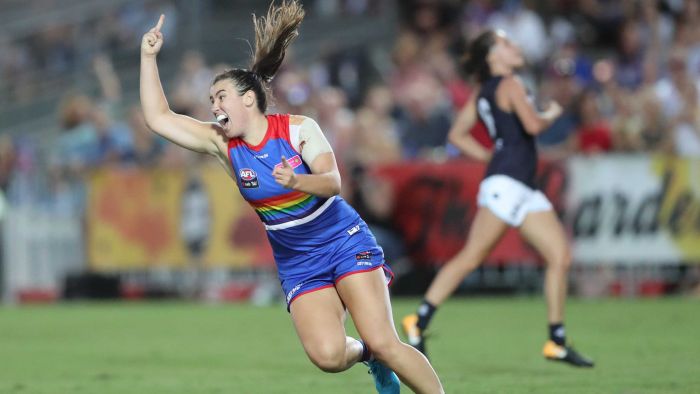The AFL women’s league has entered its fifth year and as it develops and grows, so too does the reporting of its games and players.
Key points:
- AFLW players say they “want to be critiqued on their performance” while calling for greater media coverage
- At the same time, players don’t want criticism to immediately descend to comparisons with their male counterparts
- The 2021 season — the competition’s fifth — began on Thursday night with Collingwood’s win over Carlton
However, according to a number of AFLW players, a significant disparity still remains in reporting and coverage of the men’s and women’s leagues, both in quantity and quality.
“I think it’s getting better every year. However, I just don’t think there’s enough”, Western Bulldogs player Bonnie Toogood said.
“More coverage [is needed] to grow the game because the league is still in its infancy and we need people to keep getting around it and buying into what we’re doing.”
Carlton’s Chloe Dalton, who is taking a year off to represent Australia in the Rugby Sevens at the Tokyo Olympics, feels the same.
“When I’m in Melbourne, I love grabbing a paper and flicking to the back to read about sport, and it’s quite difficult to find enough stories about AFLW and about the players themselves and their performances,” Dalton said.
Not only is the AFLW reported on significantly less than the AFL, players find the content of that reporting often falls short on analysis, statistics and proper examination.
“There’s not even a little scrutiny around players and people who’ve been recruited for certain roles and haven’t performed those roles.
“Whereas in the men’s, for example Jaidyn Stephenson, if he goes out and plays very well for North Melbourne there’s going to be so much talk about that, but there’s never anything like that for the women’s game.”
In previous seasons there has been a notion around the league that critical reporting is unwelcome by players and supporters but, in reality, many players don’t have a problem with it at all.
“I’ve read comments that people think as soon as a player is judged on their performance on the field, that there’s a big uproar and the AFLW players don’t want to read things like that,” Dalton says.
“I think that the players do want to be critiqued on their performance and people are always welcoming that feedback.”




AFL comparisons ‘annoying’ and ‘frustrating’
The players do find, however, that an issue arises when the critical analysis is applied to compare the men’s league with the women’s.
“If it’s scrutinising [the game] because of the football and because of the players and who’s performing and who’s not, that’s totally fair. We want that because that’s what makes a league better,” McCarthy says.




“But the scrutiny and the constant comparison to men’s football — I can’t speak on behalf of any other players — but personally that’s what annoys me.
“It’s not ‘this person was a marquee signing and they’re not doing anything’, it’s ‘no one’s scoring any points, which is different from the men’s football’.”
Dalton says that any comparisons between the two leagues is unfair, due to the vast differences in resources, development and opportunities afforded to male and female footballers.
“You wouldn’t compare someone’s output in a workplace who works part-time, compared to someone who works full-time hours.”
So even though scrutiny and critical analysis is welcomed, many players want it to be fair and reflective of their circumstances.




“We play the same sport but we do play it in a different way, and we do have different restrictions with training and so forth,” Toogood said.
“We are part-time athletes, so we don’t get access to the club like the men do to harness our craft as much as they do. So, of course, there could be a difference in skill level as well.
“There are all of those nitty-gritty bits of information that do get missed and don’t get covered in the media.”
‘The teacher playing football’
Another frustrating element with the match commentary for McCarthy is when she’s constantly referred to by her occupation rather than just as an elite athlete.
“For me, it kind of annoys me now — this is my fifth year, and I’m still ‘the teacher playing football’,” McCarthy said.
“No, I’m actually a footballer as well.
“I understand that some people have really interesting backstories and that’s important to get out there but referring to them as their occupation, that really annoys me because when we’re on the football field, we’re footballers.”




This is where players want to see an increase in lifestyle, opinion and feature pieces, which can help bolster knowledge of the players and the game.
“I think there’s a really strong community that love women’s footy,” Dalton said.
“I think they want to hear more about the league, and they want to hear more people’s stories, and they want to get to know the players on that level.”
At the end of the day, for the players, it’s about developing the game, on and off the field.
“All the women want to grow the game, so if we can get stories out there that help that and give more knowledge to what’s going on, that hopefully will give greater representation for the younger generation as well,” Toogood said.







